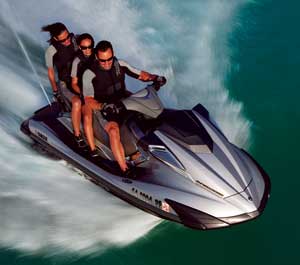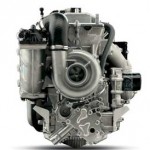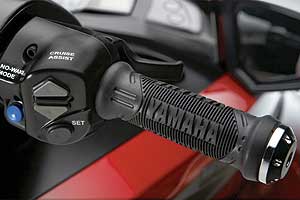2007 Yamaha Fx Sho
Yamaha WaveRunner FX SHO: PWC Review
Yamaha WaveRunner FX SHO: Our exclusive look at potent three-seater.

A sleek new cowl distinguishes the new Yamaha FX SHO from other Yamaha FX models. A new 1.8-liter supercharged engine pushes the SHO to a top speed over 65 mph with a solo rider.
Yamaha could call its new WaveRunner FX SHO the Mystery Machine. It's made of a mysterious new material Yamaha (www.yamaha-motor.com) calls NanoXcel. And it's powered by a new engine of unknown horsepower. What I do know is that the FX SHO sets a new benchmark for WaveRunner performance, and brings some great new technology to the water.
This three-passenger model is powered by a muscular new engine that is the largest-displacement mill ever dropped into a watercraft hull - a supercharged/intercooled, 1.8 liter in-line four designed specifically for marine duty. Yamaha says the new engine is narrower and shorter than the motorcycle-based, 160-hp 1.0-liter M1 engine used in its other watercraft and boat models. And unlike that 10,000- rpm screamer, the new motor peaks at a more-relaxed 7500 rpm. The supercharger is gear-driven off the end of the crankshaft.

The new Yamaha 1.8-liter engine has a gear-driven, snail-shaped supercharger located on its forward end. The engine is more compact than the 1.0-liter Yamaha M1 engine used in other Yamaha watercraft and boats.
The engine's drive-by-wire throttle enables two speed-control features. Push-button No Wake Mode holds boat speed at 5 mph. Yamaha Cruise Assist is an rpm-based speed control that can be set at any speed. The driver can then toggle the speed control up or down in 350-rpm increments to fine-tune the boat speed, a feature that will be especially handy when towing a wakeboard rider or tubers. With the computer holding boat speed absolutely steady, I found I could focus on the water ahead instead of the speedometer.
Yamaha has a new corporate policy that prevents it from publishing horsepower ratings, but based on its performance, I'm guessing the output of the new engine is in the 250-hp range. In the performance-cruiser market the FX SHO will be butting heads with the 250-hp Kawasaki Jet Ski Ultra 250X ($11,499 www.kawasaki.com), and the new 255-hp Sea-Doo RXT X ($13,299 www.sea-doo.com). The new Yamaha seems ready to run with the competition. My GPS showed an average of 65.7 mph after several wide-open blasts on a FX SHO with the fuel gauge at three-quarters full. The same machine accelerated from 0-30 mph in 2.2 seconds and 0-60 mph in 6.2 seconds.

Thumb the up and down toggle switches on the right hand control to increase or decrease Yamaha SHO engine speed in 350-rpm increments when the Cruise Assist is active.
And what is NanoXcel? This is a new SMC (sheet molding compound) material used to create the hull, deck and hull liner of the boat. Unlike most powerboat hulls, which are laid up by hand with fiberglass and resin, the SMC process places pre-cut sheets of a material that sort of looks like sticky tar paper over a steel mold. A giant press applies 3,000 tons of force and heat to the mold, and a few minutes later you've got a part that looks and feels a lot like standard fiberglass composite. SMC is a cleaner, faster, more precise process than open-molded fiberglass, but in the past the finished part was also heavier than a similar fiberglass part of equal strength. SMC consists of fiberglass strands, resin and a filler material that helps the glass and resin flow in the mold.
Yamaha says its new NanoXcel material uses an proprietary filler that was created using nano-molecular technology. The resulting parts are stronger and thinner than previous Yamaha SMC product, and also weigh 25 percent less. This shaves about 55 pounds off the over-all weight of the FX SHO, which has a published dry weight of 827 pounds. For comparison, the Jet Ski Ultra 250X weighs 904 pounds. The Sea-Doo RXT X, which has a regular fiberglass hull and deck, has a published dry weight of 818 pounds.
Some other nice features on the FX SHO include adjustable handlebars, adjustable drive trim, a remote transmitter that controls the low-speed mode and anti-theft ignition lock, and a standard boarding ladder. Yamaha will offer two SHO models. The FX SHO Cruiser ($12,799) features a fuel-flow meter, a scooped-out touring seat, and handlebars that are four inches higher than those on the standard FX SHO model ($11,999). Both sport a sleek new cowl and deck with chrome trim and corner bumpers that distinguish them from the 160-hp FX HO WaveRunners, which are back for 2008.
Yamaha Waverunner FX SHO Specifications
| Engine Type | 4-Cylinder | 4-Stroke |
| Bore/Stroke | 86 x 78mm | |
| Displacement | 1812cc | |
| Fuel | Regular Unleaded | |
| Compression Ratio | 8.6:1 | |
| Carburetor/Injection | Electronic Fuel Injection | |
| Pump | 155mm Axial Flow | |
| Impeller | 3-Blade | Stainless Steel |
| Length | 132.7" (3.37m) | |
| Width | 48.4" (1.23m) | |
| Height | 48.8" (1.24m) | |
| Dry Weight | 827 lb (376 kg) | |
| Fuel Capacity | 18.5 gal (70 L) | |
| Vehicle Capacity | 3 person/ 529 lb (240 kg) | |
| Storage Capacity | 26.4 gal (100 L) | |
| Hull Material | NanoXcel | |
| Warranty | 1 year limited warranty | |
| Color | Stealth Black; Metallic Midnight Blue |
Written by: Charles Plueddeman
Charles Plueddeman is Boats.com's outboard, trailer, and PWC expert. He is a former editor at Boating Magazine and contributor to many national publications since 1986.
Source: https://www.boats.com/reviews/yamaha-waverunner-fx-sho-review/







Tidak ada komentar:
Posting Komentar